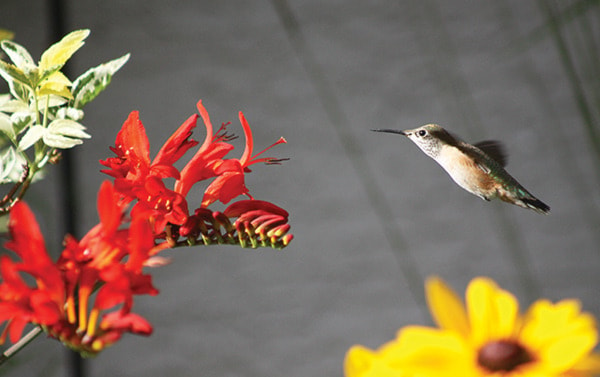At this time of year a great many people put out hummingbird feeders and enjoy the antics of these delightful little creatures as they zip about at breakneck speed.
Hummingbird feeders have several advantages over seed feeders for song birds — firstly, hummingbird food (sugar water) is less expensive than bird seed and secondly there is no big mess that can occur as the birds drop seeds and seed hulls all over beneath the feeder. So hummingbird feeders are appropriate for apartment balconies and decks whereas seed feeders often are not.
Eighteen species of hummingbirds occur in North America north of the Mexican border. Here in the south end of the valley we typically get four species, although definitely not in equal numbers.
The most common “hummer” is the calliope hummingbird. It is the smallest of all North American hummingbirds. Next most common is the Rufous hummingbird, which is actually the easiest to identify because of its’ Rufous (reddish-brown) colour. Anna’s hummingbird is the least common of the four while Black-chinned is somewhat more common. Anna’s is mostly a coastal B.C. bird while Rufous is found nearly everywhere in B.C. except in the Peace River region of the northeast. The other two are generally found only in the Southern Interior.
May through early August are the peak months for hummingbirds in the South Okanagan, although some do arrive earlier and others stay later. Anna’s have actually been found in our valley in almost every month of the year — perhaps wandering up here from the coast.
Now a word of caution about feeding hummingbirds — you must clean the feeders regularly! The feeders should be emptied and thoroughly washed a minimum of twice a week and in hot weather such as we’ve been having already this year, you should empty and wash them at least three times a week. Otherwise you could be killing your birds. Nectar ferments very easily in hot weather and molds associated with this fermentation can not only kill the actual feeding bird, but can be transmitted back to the nest and kill the baby hummers. Do not wash the feeder bottles with soap (although I have seen mixed messages about this); rather use a mild bleach solution and then rinse well. Another word of caution — do not make your nectar solution using honey or artificial sweeteners; use only white table sugar — that comes closest to natural nectar and do not add red colouring agents to the sugar solution. Generally it is best to make your feeder solution using one part sugar to four parts water but early in the season and late in the season when the birds are migrating it is okay to make a stronger solution using one part sugar to three parts water. Studies have found that the higher the caloric count of the food, the less often the birds come to the feeder. So while the birds might really enjoy your three to one or even two to one solution, you’ll see less of them.
In summary, practice good hygiene with your feeders, be moderate in your food solution and enjoy these most amazing birds. For more info just Google “feeding hummingbirds” and you’ll have a wealth of information. The next monthly meeting of the South Okanagan Naturalists’ Club will not be until September. In the meantime check out our website (southokanagannature.com) for details about weekly birding outings and special trips around the south Okanagan.
Bob Handfield is past-president of the South Okanagan Naturalists’ Club but the views expressed here are his own and not necessarily those of the Club
